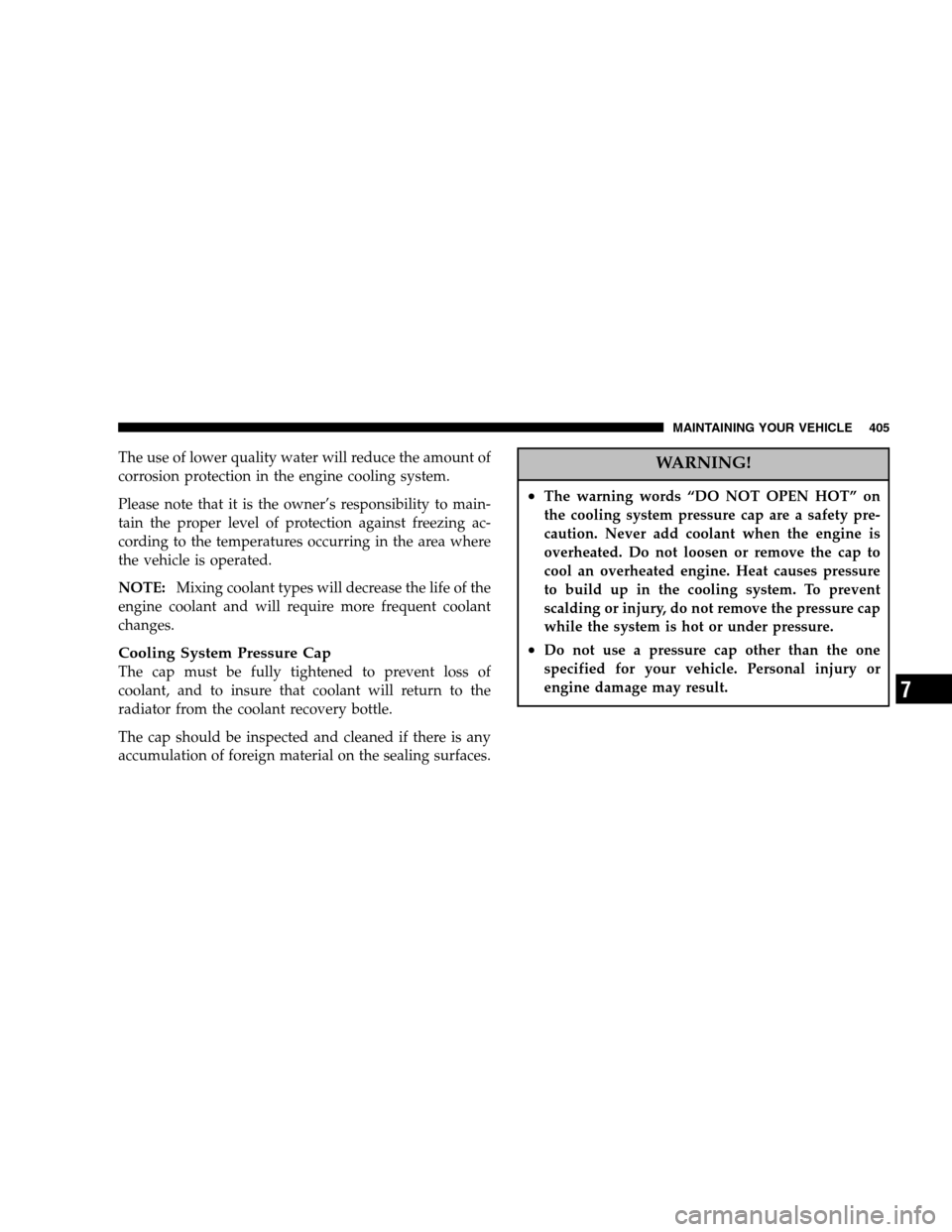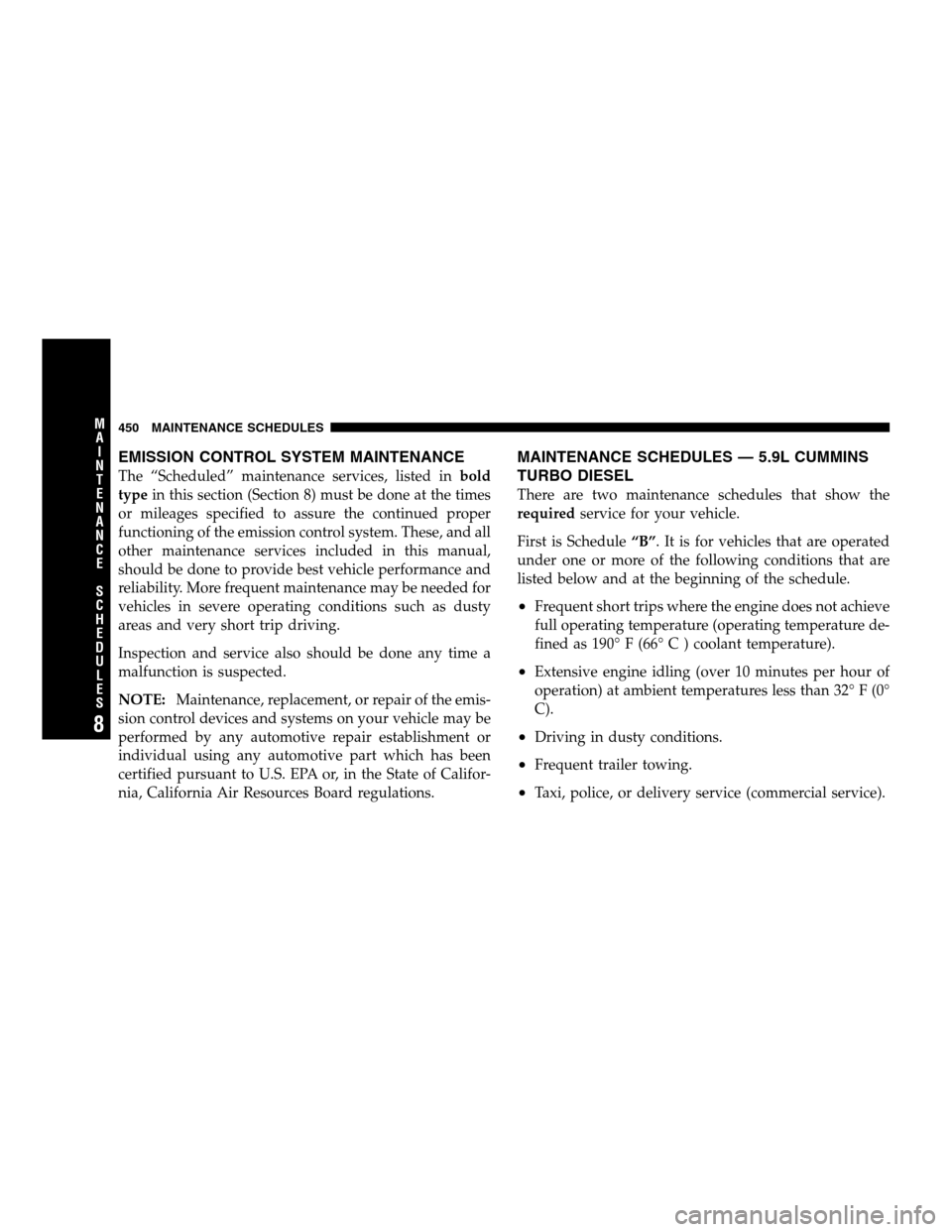Page 405 of 496

The use of lower quality water will reduce the amount of
corrosion protection in the engine cooling system.
Please note that it is the owner’s responsibility to main-
tain the proper level of protection against freezing ac-
cording to the temperatures occurring in the area where
the vehicle is operated.
NOTE: Mixing coolant types will decrease the life of the
engine coolant and will require more frequent coolant
changes.
Cooling System Pressure Cap
The cap must be fully tightened to prevent loss of
coolant, and to insure that coolant will return to the
radiator from the coolant recovery bottle.
The cap should be inspected and cleaned if there is any
accumulation of foreign material on the sealing surfaces.
WARNING!
•The warning words “DO NOT OPEN HOT” on
the cooling system pressure cap are a safety pre-
caution. Never add coolant when the engine is
overheated. Do not loosen or remove the cap to
cool an overheated engine. Heat causes pressure
to build up in the cooling system. To prevent
scalding or injury, do not remove the pressure cap
while the system is hot or under pressure.
•Do not use a pressure cap other than the one
specified for your vehicle. Personal injury or
engine damage may result.
MAINTAINING YOUR VEHICLE 405
7
Page 406 of 496

Disposal Of Used Engine Coolant
Used ethylene glycol based engine coolant is a regulated
substance requiring proper disposal. Check with your
local authorities to determine the disposal rules for your
community. Do not store ethylene glycol-based engine
coolant in open containers or allow it to remain in
puddles on the ground. Prevent ingestion by animals and
children. If ingested by a child, contact a physician
immediately. Clean up any ground spills immediately.
Coolant Level
The coolant bottle provides a quick visual method for
determining that the coolant level is adequate. With the
engine cold, the level of the coolant in the coolant
recovery bottle should be between the ranges indicated
on the bottle.
The radiator normally remains completely full, so there is
no need to remove the radiator cap unless checking for
coolant freeze point or replacing coolant. Advise your service attendant of this. As long as the engine operating
temperature is satisfactory, the coolant bottle need only
be checked once a month.
When additional coolant is needed to maintain the
proper level, it should be added to the coolant bottle. Do
not overfill.
Points To Remember
NOTE:
When the vehicle is stopped after a few miles (a
few kilometers) of operation, you may observe vapor
coming from the front of the engine compartment. This is
normally a result of moisture from rain, snow, or high
humidity accumulating on the radiator and being vapor-
ized when the thermostat opens, allowing hot coolant to
enter the radiator.
If an examination of your engine compartment shows no
evidence of radiator or hose leaks, the vehicle may be
safely driven. The vapor will soon dissipate.
406 MAINTAINING YOUR VEHICLE
Page 407 of 496

•Do not overfill the coolant recovery bottle.
•Check coolant freeze point in the radiator and in the
coolant recovery bottle. If antifreeze needs to be
added, contents of coolant recovery bottle must also be
protected against freezing.
•If frequent coolant additions are required, or if the
level in the coolant recovery bottle does not drop when
the engine cools, the cooling system should be pres-
sure tested for leaks.
•Maintain coolant concentration at 50% HOAT engine
coolant (minimum) and distilled water for proper
corrosion protection of your engine which contains
aluminum components.
•Make sure that the radiator and coolant recovery
bottle overflow hoses are not kinked or obstructed.
•Keep the front of the radiator clean. If your vehicle is
equipped with air conditioning, keep the front of the
condenser clean, also.
•Do not change the thermostat for summer or winter
operation. If replacement is ever necessary, install
ONLY the correct type thermostat. Other designs may
result in unsatisfactory coolant performance, poor gas
mileage, and increased emissions.
Fan
Inspection
Check the fan for cracks and bent or broken blades. If any
of these conditions exist, you must replace the fan. Make
sure it is securely mounted.
NOTE: This service procedure must be performed by a
trained service technician. Make arrangements with your
authorized Dodge Truck Dealer for this inspection.
MAINTAINING YOUR VEHICLE 407
7
Page 446 of 496
FLUIDS, LUBRICANTS AND GENUINE PARTS
Engine
Component Fluids, Lubricants and Genuine Parts
Engine Coolant Mopar �Antifreeze/Coolant 5 Year/100,000 Mile Formula HOAT (Hybrid Or-
ganic Additive Technology) or equivalent.
Engine Oil For the proper quality and SAE Grade oil for your engine, refer to the section � Maintenance Procedures.�
Engine Oil Filter Mopar �Engine Oil Filter, P/N 05083285AA or equivalent.
Engine Fuel Filter Mopar �Fuel Filter, P/N 05015581AB or equivalent.
Fuel Selection Use good quality diesel fuel from a reputable supplier. For most year-round service, No. 2 diesel fuel meeting ASTM specification D-975 will provide
good performance. This vehicle is fully compatible with biodiesel blends
up to 5% biodiesel meeting ASTM specification D-975. (See page 318 for
more information.)
446 MAINTAINING YOUR VEHICLE
Page 450 of 496

EMISSION CONTROL SYSTEM MAINTENANCE
The “Scheduled” maintenance services, listed inbold
type in this section (Section 8) must be done at the times
or mileages specified to assure the continued proper
functioning of the emission control system. These, and all
other maintenance services included in this manual,
should be done to provide best vehicle performance and
reliability. More frequent maintenance may be needed for
vehicles in severe operating conditions such as dusty
areas and very short trip driving.
Inspection and service also should be done any time a
malfunction is suspected.
NOTE: Maintenance, replacement, or repair of the emis-
sion control devices and systems on your vehicle may be
performed by any automotive repair establishment or
individual using any automotive part which has been
certified pursuant to U.S. EPA or, in the State of Califor-
nia, California Air Resources Board regulations.
MAINTENANCE SCHEDULES — 5.9L CUMMINS
TURBO DIESEL
There are two maintenance schedules that show the
required service for your vehicle.
First is Schedule “B”. It is for vehicles that are operated
under one or more of the following conditions that are
listed below and at the beginning of the schedule.
•Frequent short trips where the engine does not achieve
full operating temperature (operating temperature de-
fined as 190° F (66 ° C ) coolant temperature).
•Extensive engine idling (over 10 minutes per hour of
operation) at ambient temperatures less than 32° F (0°
C).
•Driving in dusty conditions.
•Frequent trailer towing.
•Taxi, police, or delivery service (commercial service).
450 MAINTENANCE SCHEDULES
8
M A I
N T
E
N A
N C E
S
C
H E
D
U L
E
S
Page 451 of 496

•Off-road or desert operation.
•Extensive operation at high engine speeds (greater
than 2900 rpm) and loads (greater than 70% throttle).
NOTE: Most vehicles are operated under the conditions
listed for Schedule �B�.
NOTE: IfANY of these apply to you then change your
coolant every 101,250 miles (162 000 km) or 60 months,
whichever comes first and follow schedule “B” of the
� Maintenance Schedules �section of this manual.
Second is Schedule “A”. It is for vehicles that are not
operated under any of the conditions listed under Sched-
ule �B�.
Use the schedule that best describes your driving condi-
tions. Where time and mileage are listed, follow the
interval that occurs first.
CAUTION!
Failure to perform the required maintenance items
may result in damage to the vehicle.
At Each Stop for Fuel
•Check the engine oil level about 15 minutes after a
fully warmed engine is shut off. Checking the oil level
while the vehicle is on level ground will improve the
accuracy of the oil level reading. Add oil only when
the level is at or below the ADD or MIN mark.
•Check the windshield washer solvent and add if
required. When refilling the washer fluid reservoir,
take some washer fluid and apply it to a cloth or towel
and wipe clean the wiper blades, this will help blade
performance.
MAINTENANCE SCHEDULES 451
8
M A I
N T
E
N A
N C E
S
C
H E
D
U L
E
S
Page 452 of 496
Once a Month
•Check tire pressure and look for unusual wear or
damage.
•Inspect the batteries and clean and tighten the termi-
nals as required.
•Check the fluid levels of coolant reservoir, brake
master cylinder, and transmission and transfer case (if
equipped), add as needed.
•Check Filter Minder™. Replace air cleaner filter
element if necessary.
•Check all lights and all other electrical items for correct
operation.
•Drain water from the fuel filter. At Each Oil Change
•Change the engine oil filter.
•Inspect the exhaust system.
•Inspect the brake hoses.
•Inspect the U-Joints ( if equipped) and front suspen-
sion components.
•Check the automatic transmission fluid level.
•Check the manual transmission fluid level.
•Check the coolant level, hoses, and clamps.
•Lubricate outer tie rod ends.
•Lubricate Front Drive Shaft Fittin
452 MAINTENANCE SCHEDULES
8
M
A I
N T
E
N A
N C E
S
C
H E
D
U L
E
S
Page 453 of 496
Schedule “B”
Follow schedule “B” if you usually operate your vehicle
under one or more of the following conditions.
•Frequent short trips where the engine does not achieve
full operating temperature (operating temperature de-
fined as 190° F (66 ° C ) coolant temperature).
•Extensive engine idling (over 10 minutes per hour of
operation) at ambient temperatures less than 32° F (0°
C).
•Driving in dusty conditions.
•Frequent trailer towing.
•Taxi, police, or delivery service (commercial service).
•Off-road or desert operation.
•Extensive operation at high engine speeds (greater
than 2900 rpm) and loads (greater than 70% throttle).
NOTE: IfANY of these apply to you then change your
coolant every 101,250 miles (162 000 km) or 60 months,
whichever comes first and follow schedule “B” of the
� Maintenance Schedules �section of this manual.
SCHEDULE “B” 453
8
M
A I
N T
E
N A
N C E
S
C
H E
D
U L
E
S